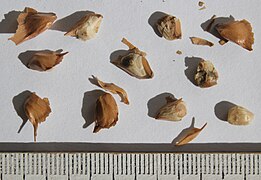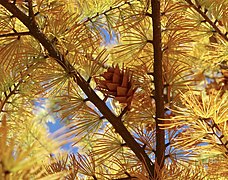| Pseudolarix amabilis Temporal range: 49–0 Ma PreꞒ Ꞓ O S D C P T J K Pg N Early Eocene to recent | |
|---|---|

| |
| Conservation status | |
 Vulnerable (IUCN 3.1) | |
| Scientific classification | |
| Kingdom: | Plantae |
| Clade: | Tracheophytes |
| Clade: | Gymnospermae |
| Division: | Pinophyta |
| Class: | Pinopsida |
| Order: | Pinales |
| Family: | Pinaceae |
| Subfamily: | Abietoideae |
| Genus: | Pseudolarix |
| Species: | P. amabilis |
| Binomial name | |
| Pseudolarix amabilis (N. Nelson) Rehder | |
| Synonyms | |
| |
Pseudolarix amabilis is a species of coniferous tree in the pine family Pinaceae. The species is commonly known as golden larch, but being more closely related to Keteleeria, Abies and Cedrus, is not a true larch (Larix). P. amabilis is native to eastern China, occurring in small areas in the mountains of southern Anhui, Zhejiang, Fujian, Jiangxi, Hunan, Hubei and eastern Sichuan, at altitudes of 100–1,500 m (328–4,921 ft). The earliest known occurrences are of compression fossils found in the Ypresian Allenby Formation and mummified fossils found in the Late Eocene Buchanan Lake Formation on Axel Heiberg Island.
Growth
It is a deciduous coniferous tree reaching 30–40 m (98–131 ft) tall, with a broad conic crown. The shoots are dimorphic, with long shoots and short shoots similar to a larch, though the short shoots are not so markedly short, lengthening about 5 mm annually. The leaves are bright green, 3–6 cm long and 2–3 mm broad, with two glaucous stomatal bands on the underside; they turn a brilliant golden yellow before falling in the autumn, hence the common name "golden larch". The leaves are arranged spirally, widely spaced on long shoots, and in a dense whorl on the short shoots.
The cones are distinctive, superficially resembling small globe artichokes, 4–7 cm long and 4–6 cm broad, with pointed triangular scales; they mature about 7 months after pollination, when (like fir and cedar cones) they disintegrate to release the winged seeds. The male cones, as in Keteleeria, are produced in umbels of several together in one bud.
Characteristics
The golden larch is an attractive ornamental tree for parks and large garden. Unlike the true larches, it is tolerant of summer heat and humidity, growing successfully in the southeastern United States where most larches and firs do not succeed. In Europe growth is most successful in the Mediterranean region with notable specimens in northern Italy; further north in the United Kingdom it will grow, but only very slowly due to the cooler summers.
This plant has gained the Royal Horticultural Society's Award of Garden Merit.
Gallery
-

-
 Closeup of bark
Closeup of bark
-
 Seeds without wings
Seeds without wings
-
 Pollen cones
Pollen cones
-
 Maturing female cones
Maturing female cones
-
 Needles and mature cone in fall
Needles and mature cone in fall
-
 Needle detail in fall
Needle detail in fall
-
Bonsai example
References
- Yang, Y.; Christian, T. (2013). "Pseudolarix amabilis". IUCN Red List of Threatened Species. 2013: e.T34196A2850347. doi:10.2305/IUCN.UK.2013-1.RLTS.T34196A2850347.en. Retrieved 12 November 2021.
- LePage, B. A.; Basinger, J. F. (1995). "Evolutionary history of the genus Pseudolarix Gordon (Pinaceae)". International Journal of Plant Sciences. 156 (6): 910–950. doi:10.1086/297313. S2CID 84724593.
- "Pseudolarix amabilis AGM". Royal Horticultural Society. Retrieved July 14, 2012.
- "AGM Plants - Ornamental" (PDF). Royal Horticultural Society. July 2017. p. 83. Retrieved 2 June 2018.
External links
- Pseudolarix amabilis images at the Arnold Arboretum of Harvard University Plant Image Database
- Friedman, William (Ned). "Golden larches never disappoint." Posts from the Collection, Arnold Arboretum of Harvard University website, 18 November 2019. Accessed 13 May 2020.
- Rose, Nancy. "Not All Conifers are Evergreen." Arnold Arboretum of Harvard University website, 6 January 2016. Accessed 13 May 2020.
- Friedman, William (Ned). "Leaf shadows on Peter Hill." Posts from the Collection, Arnold Arboretum of Harvard University website, 18 November 2019. Accessed 13 May 2020.
- Arboretum de Villardebelle - photos of cones
- Gymnosperm Database
- Pseudolarix in the Flora of China
- Article in Harvard University Bulletin of Popular Information (1919)
| Taxon identifiers | |
|---|---|
| Pseudolarix amabilis |
|
| Larix amabilis | |